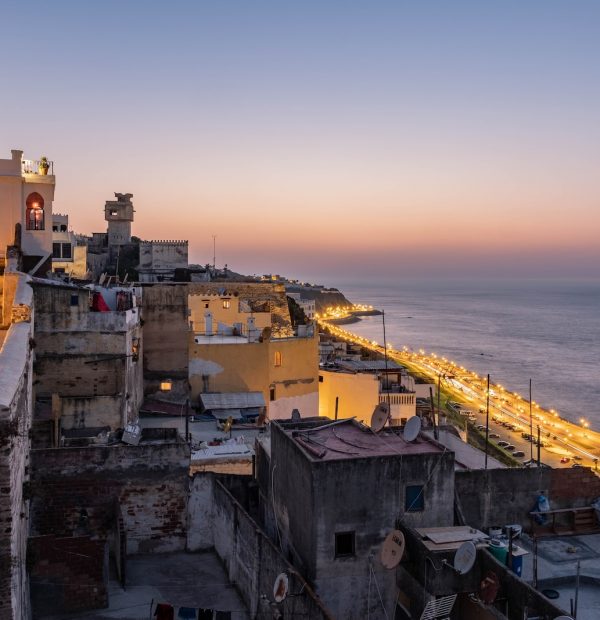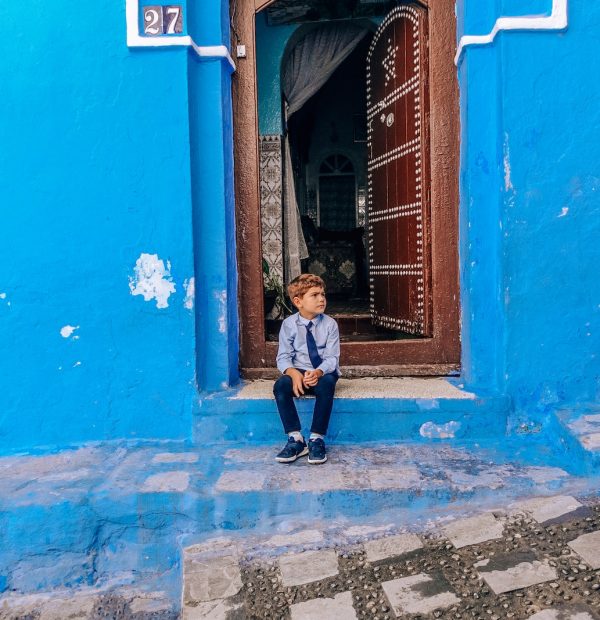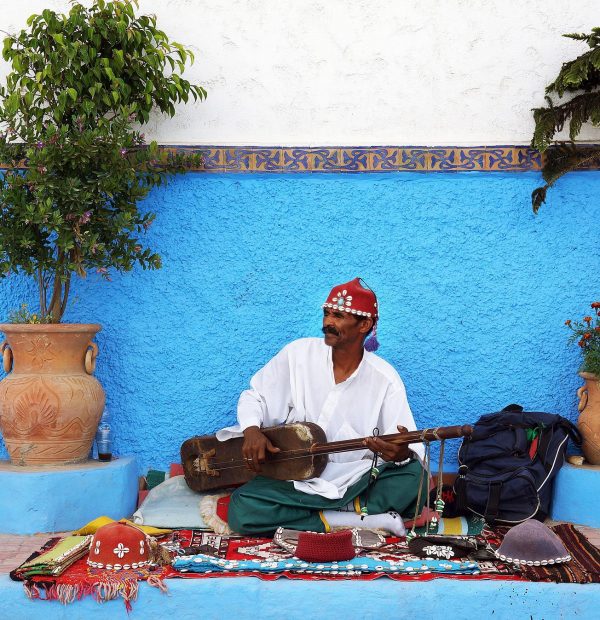TANGIER
Tangier

Tangier is a city in northern Morocco with a population of around 850,000 people. It is located on the Strait of Gibraltar, just 14 kilometers (9 miles) from Spain. Because of its location, Tangier has been occupied by a number of different civilizations over the centuries, including the Romans, Vandals, Byzantines, Arabs, and Europeans.
The city’s history and cosmopolitan atmosphere make it a popular tourist destination. Tangier is also home to a large number of expatriates from Europe and North America.
History
Tangier was founded in the early 5th century BC by the Carthaginians, who were looking for a strategic base to control the western Mediterranean. It was first inhabited by the Berbers, who were later displaced by the Phoenicians. The city then came under the control of the Romans, who made it an important staging post for their campaigns in Africa. In the early 5th century, it was conquered by the Vandals, before being reconquered by the Byzantine Empire in the 6th century.
Pre-colonial
Tangier was first settled by the Phoenicians in the 9th century BCE. It later became a hub for the Carthaginians. The city was conquered by the Romans in the 3rd century BCE, and then by the Vandals in 429 CE. The Byzantines recaptured it in 533 CE, and it remained in their hands until the Arab conquest in 647 CE.
Colonial
Tangier was first inhabited by Neolithic Berber hunter-gatherers who were attracted by the rich resources of the coast and nearby mountains. It was one of many ports controlled by the Phoenicians, a maritime culture that flourished between 1550 BC and 300 BC. They founded the city of Tingis around 3 centuries BC and developed it into a hub of maritime trade. The Phoenicians used Tangier as a base for trade with the West African hinterland.
Post-colonial
Tangier was a cosmopolitan city during the colonial period, with a diverse population of Arabs, Berbers, Jews, and Europeans. After the independence of Morocco in 1956, Tangier became a focal point for Moroccan intellectuals and artists seeking to create a new Moroccan identity. In the 1960s and 1970s, Tangier was also a popular destination for Western hippies and artists seeking an alternative lifestyle.
In the 1980s and 1990s, Tangier’s economy declined due to competition from other Moroccan cities and the rise of Islamic fundamentalism. However, the city has experienced a renaissance in recent years, with a growing number of tourists and investment in infrastructure.
Geography
Tangier is situated in North Africa at the western end of the Straits of Gibraltar, where the Mediterranean Sea meets the Atlantic Ocean. The city has a long history, dating back to the early days of the Phoenician civilization. Tangier is a popular tourist destination, known for its beautiful beaches, stunning architecture, and vibrant nightlife.
Location
Tangier is located in northwest Morocco on the Strait of Gibraltar, where the Mediterranean Sea meets the Atlantic Ocean. The city’s name is derived from the Berber word ṭngr, which means “the narrows”. It has a Mediterranean climate with mild, wet winters and warm, dry summers.
Climate
Tangier has a typical Mediterranean climate with mild, wet winters and hot, dry summers. The average yearly temperature is about 21 °C (70 °F), and average yearly precipitation is about 660 mm (26 in). Winters are cool and rainy, from December to February, while summers are hot and dry, from June to September. Spring and autumn are generally mild with moderate temperatures and changeable weather.
Topography
Tangier is located along the northwest coast of Africa on the Strait of Gibraltar. The city has a Mediterranean climate with mild, wet winters and warm, dry summers. The average high temperature in July is 81 degrees Fahrenheit (27 degrees Celsius) and the average low temperature in January is 42 degrees Fahrenheit (6 degrees Celsius).
The city’s landscape is hilly and mountainous, with the Rif Mountains visible to the north and west. Tangier’s primary natural resources are phosphate rock and seafood. The city is also home to a number of historical and cultural landmarks, including the Kasbah Museum, the American Legation Museum, and the Grand Mosque of Tangier.
Demographics
Tangier is a city located in the extreme northwest of Africa overlooking the Strait of Gibraltar. As of 2018, the city has a population of around 850,000 people. The majority of the population is of Arab or Berber descent, with a small minority of European descent. The city has a rich history, dating back to the 7th century when it was founded by the Phoenicians.
Population
The population of Tangier is approximately 850,000 people. The city is predominantly Muslim, with a Christian minority. The majority of the population is of Arab descent, but there are also Berber, Spanish, French, and Italian influences. The majority of the population speaks Arabic, but French and Spanish are also commonly spoken.
Language
The city of Tangier is home to a diverse population, with a variety of languages spoken throughout the city. The most common languages spoken in Tangier are Arabic, French, and Spanish. However, there is also a significant population of English speakers in the city.
Religion
The city of Tangier is home to a large number of religious leaders and followers. The city has a significant number of mosques, churches, and other religious buildings. The majority of the city’s population is Muslim, with a significant minority of Christians. There are also a small number of Jews and other religious groups.
Culture
Tangier is a city in northern Morocco with a rich history and culture. The city is known for its beautiful architecture, tasty food, and friendly people. Tangier is a great place to visit if you’re looking to experience a different culture.
Arts
Tangier is home to a vibrant arts scene, with many local artists working in a variety of mediums. The city is also home to several art galleries and museums, including the Museum of Contemporary Art, the Museum of Islamic Art, and the Tangier Museum of Modern Art. In addition, Tangier hosts a number of annual art festivals, including the Tangier International Film Festival and theTangier International Jazz Festival.
Music
Tangier has a rich and vibrant musical culture, with a wide variety of music styles and genres being represented. From the traditional music of the Gnawa to the more modern sounds of raï and hip-hop, there is something for everyone in Tangier.
The Gnawa are a group of musicians who play traditional music from North Africa. The music is based on the use of a three-stringed lute called the gimbri, and is often accompanied by singing and dancing. The Gnawa are said to be able to cure illnesses through their music, and their music is often played at weddings and other celebrations.
Raï is a type of Algerian folk music that became popular in the 1970s. It is characterized by its use of electric instruments, including guitars, keyboards, and drums, as well as its sexually explicit lyrics. Raï has been controversial in Algeria due to its depictions of alcohol, drugs, and sex, but it remains popular among many young Algerians.
Hip-hop is also popular among young people in Tangier. There are several hip-hop crews in the city, who compete against each other in battles. Hip-hop provides a way for young people to express themselves and their social frustrations.
Cuisine
The city of Tangier is known for its wide variety of cuisine. There are many restaurants that serve both local and international dishes. The city is also home to a number of bakeries and cafes that offer a variety of pastries and coffee.
Tourism
The city of Tangier is located in the northwest corner of Africa, and it is a popular tourist destination. The city is known for its beautiful beaches, its vibrant nightlife, and its rich history. Tangier is a melting pot of cultures, and you can find a little bit of everything in this city.
attractions
The city of Tangier is a popular tourist destination for a number of reasons. Its location on the strait of Gibraltar makes it a convenient stopover point for travelers between Europe and Africa. Tangier is also home to a number of historical and cultural attractions, including the medina (old city), the kasbah (fort), and the American Legation Museum.
Infrastructure
The city of Tangier is located in the northwest corner of Africa and has a long history of being a crossroads of culture and trade. The city has a modern infrastructure that includes an international airport, a seaport, and a network of highways and railways. Tangier is also home to a number of universities and colleges.
Transportation
The city of Tangier is served by a number of transportation options, including a domestic airport, a major seaport, and a railway station. There are also a number of bus and taxi services operating within the city.
The domestic airport, located just outside of the city center, offers regular flights to major cities across Morocco. The seaport is one of the busiest in North Africa and handles a large volume of cargo traffic each year. The railway station is located in the central part of the city and offers direct service to Rabat, the capital of Morocco.
There are several bus companies providing service within Tangier. These include public buses operated by the government-run Tangier Transit Authority, as well as private companies such as CTM and Supratours. Taxis are also widely available and can be hailed from the street or ordered by phone.
Utilities
Tangier’s utilities are provided by the Tangier Municipal Utility Commission. The commission is responsible for the city’s water, sewer, and stormwater systems. It also operates the city’s electric power grid.



